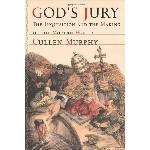If you were hunting for a book most ReadWriteWeb readers would, based on the title, find irrelevant to their pursuits, you could do worse than “God’s Jury: The Inquisition and the Making of the Modern World” by Cullen Murphy. But, as Murphy adeptly shows, both information technology and the institutional corruption of privacy would not have assumed their current forms without the Inquisition.

The first thing Murphy does is to disabuse us of the notion of “the” Inquisition; there were in fact three, the medieval (late 12th, early 13th centuries), the Spanish (beginning in the 15th ) and the Roman (16th-17th centuries). But despite the fact that this part of European history is less monolithic than common wisdom usually portrays it, the Inquisition was a turning-point in information centralization, and that information was centralized with new technologies.
The Medieval Sysadmin
Inquisitors were the first group of transnational actors to need a great deal of information at their fingertips. As Murphy says:
“Conducting countless interrogations and working constantly, they needed records from the past that they could access quickly. Had some defendant come before the Inquisition previously – even 10 or 20 years earlier? Had any immediate family members been identified as heretics – or anyone in the extended family? … Information on all these matters was essential, and the inquisitors designed record-keeping procedures to meet their needs. They created, in effect, the equivalent in parchment of search engines.”
“The mere idea that information can be centralized and made widely available, the practice of modifying or creating technology to do so, as well as some of the enduring methods for sharing data, come to us directly from an organization that is best known for burning people alive.” – Cullen Murphy
In organizing information, members of the Inquisition, it could be argued, created information technology. Aspects of organization we still use – even on this page – began then, including taxonomy and tagging. (Among other methods, each record had a boxed synopsis in the margin that allowed officials to identify relevant documents at a glance.)
The Inquisition was accompanied by an information explosion, analogous to the 20th century’s, if more prolonged. To give one example, Pope Innocent III (who died in the early 13th century) sent out 300 official Church letters in a given year. Less than a century later, Boniface VIII sent out 50,000.
The mere idea that information can be centralized and made widely available, the practice of modifying or creating technology to do so, as well as some of the enduring methods for sharing data, come to us directly from an organization that is best known for burning people alive.
The Dominican Web
The religious order most closely associated with the Inquisition was the Dominican. It arose at the same time as the Franciscan order. What it provided to the Church was the interface to the data, the Web to the Inquisition’s Internet.
The change the order represented is hard to overestimate, Murphy wrote.
“In a largely static society – the typical peasant might spend an entire lifetime with a tight radius around his birthplace – the radical character of these aggressively itinerant agents, wielding transcendent power, proved highly advantageous.”
“He wanted detail: names, dates, numbers, locations, relationships. To exert control you must nail people down: identify them, count them, deep track of them put them in context.” – Cullen Murphy
One of the example he outlines is that of the French village of Montaillou, adjacent to the Pyrenees mountains. The village was the last, alleged holdout of the heretical
and the target of the Inquisition’s Jacques Fornier, the bishop of Pamiers, and later Pope. The perpetual motion machine of Fournier’s investigation sounds like a description of the Web itself, an infinitely-detailed, constantly-forking sump of detail, some sordid, much personal.
“Over a period of years (Fournier) probed into the smallest intimacies of (the villagers’) personal lives – not only their beliefs but also their tastes and habits, whom they liked and disliked, their sexual practices, the village gossip. He wanted detail: names, dates, numbers, locations, relationships. To exert control you must nail people down: identify them, count them, deep track of them put them in context.”
This extreme, but by not terribly unusual, example of the Inquisitions’ activities, and of the informational artifacts it produced, prefigured the shape and consequences of online social network. Like the captured information and activity of a group of Facebook users, say, this data means everything and nothing but can be used for social control.
Imagine the village as a village in China, for instance, full of Falun Gong practitioners. Imagine the Inquisition as the Communist Party and an electronic enforcement chief standing in for Fournier. It doesn’t take much effort to do so. The Inquisition, Murphy maintains, provided a model for the gathering and exploitation of information in the service of social control under a small group, a model that persists to this day.
The Sanctity of Private Conscience
The aggregation of information seems to result, almost as a function of its constitution, in an institutional offense at the existence of privacy. Privacy, after all, is a block to complete aggregation and bureaucracy is like a virus: it exists to reproduce itself at the expense of any competitor.
Murphy, however, makes the case that the invasion and destruction of privacy is a result not of information centralization itself but of the certainty powering those behind it.
“In a world of moral certainty, the unthinkable becomes permissable. The sanctity of private conscience was no longer deemed inviolate, and techniques for ensnaring the innocent in scenarious of scripted guilt became increasingly sophisticated and systemic… ‘The medieval inquisitors had perfected tecniquest by which the very fabric of reality could be altered.'”
“In a world of moral certainty, the unthinkable becomes permissable. The sanctity of private conscience was no longer deemed inviolate, and techniques for ensnaring the innocent in scenarious of scripted guilt became increasingly sophisticated and systemic.” – Cullen Murphy
Look at the nature of privacy violation today and at its agents. Invariably, the justification for it is service to a higher ideal and the higher beings who represent it (and in reality, benefit from it).
Politicians in the United States have directed their representatives to torture human beings (the ultimate in privacy violation) because “America” is more important than twee sensibility; media companies are attempting to force the closure of websites, in a push for guilt-by-association, in the name of intellectual property rights; and in Saudi Arabia, authorities are calling for the murder of a young man because he aired his religious doubts on Twitter.
The agency behind these present violations is the same “moral certitude” that Murphy describes as powering the transgressions of the Inquisition. We have the Inquisition to thank for the example we follow in connecting the True Believer to the war on privacy; this despite doubt being as integral to the progress of technology, economics and government as it is to the exaltation of faith.
What “God’s Jury” reminds us is that this unprecedented centralization and proliferation of information we are currently experiencing, and the liabilities that have resulted from it, do indeed have precedents. If we’re attentive and critical, and full of doubt, we may prove able to mitigate its worst excesses and most egregious transgressions.
“Auto da fé? What’s an auto da fé?”
“It’s what you oughtn’t to do but you do anyway!”










